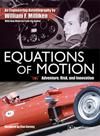|
Equations of Motion -
Adventure, Risk and Innovation
Price: $39.95
|
Vintage Airplane - June 2007
Review of Equations of Motion from Vintage Airplane
EAAer Bill Milliken"s engineering autobiography, Equations of Motion, is a great read if you"re an engineering-oriented individual. If you"re not a "tech-head" or an engineer, it may not be your cup of calculus, but I found it quite fascinating. I"m not an engineer, so some of Milliken"s math-based discussions were over my head, but it never hurts to stretch the mind and learn something new, and for me this book certainly helped fill in some of the details related to the factors that influence vehicle handling, among other interesting mechanical concepts.
Milliken, who was born in 1911, has a remarkable recall of details (or a willingness to do the research to ferret out those details) that made this book entertaining as well. Starting as a youngster with his fascinations of race cars and aviation, he grew up during the Lindbergh aviation boom and the 1930s. He was building push cars with his pals while in elementary school and has not stopped being curious about all things mechanical ever since. He built a homebuilt biplane powered with a Heath-Henderson engine, dubbed the M-I, while in school at MIT. After graduation, he worked as a Boeing test engineer during World War II, and his detailed insight into the workings of the then very new engineering concepts of flight test analysis of large airplanes was captivating. Later, as one of the founding members of the Sports Car Club of America races (SCCA) at Watkins Glen, he was a pioneering sports car racer and builder. His detailed and studied work with the Cornell University Aeronautical Laboratory (where he founded the Transportation Research Division) led not only to greater knowledge of stability and control of aircraft, but also to the first work done to quantify and improve the handling of automobiles in the United States.
The aviation work is quite interesting, but I must admit I found myself most taken by his descriptions of the earliest work done by the SCCA in the postwar days, as road and track racing in the United States really started to take off, and the sports car craze became part of the calmer days following the war.
The 683-page book, published by Bentley Publishers, is well written and edited and illustrated with great photos of both his aviation and automobile careers, including in depth documentation of his design and construction of his MX-I race car, which featured a suspension with all four wheels significantly negatively cambered. Why? Well, you"ll have to read it to find out!
Review of Equations of Motion from Vintage Airplane - June 2007
![[B] Bentley Publishers](http://assets1.bentleypublishers.com/images/bentley-logos/bp-banner-234x60-bookblue.jpg)
